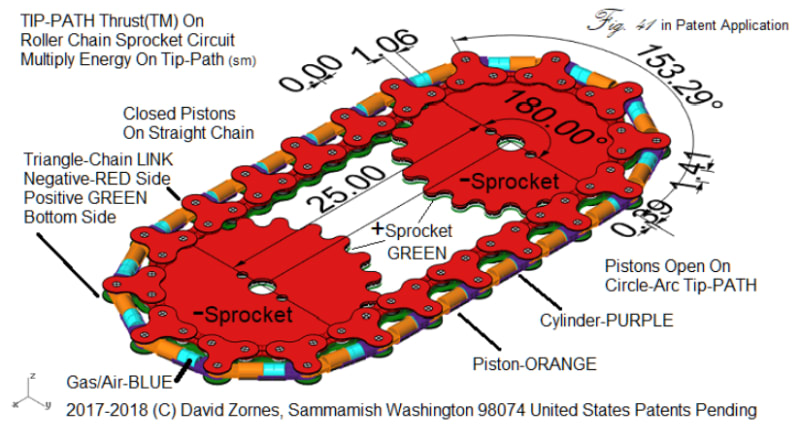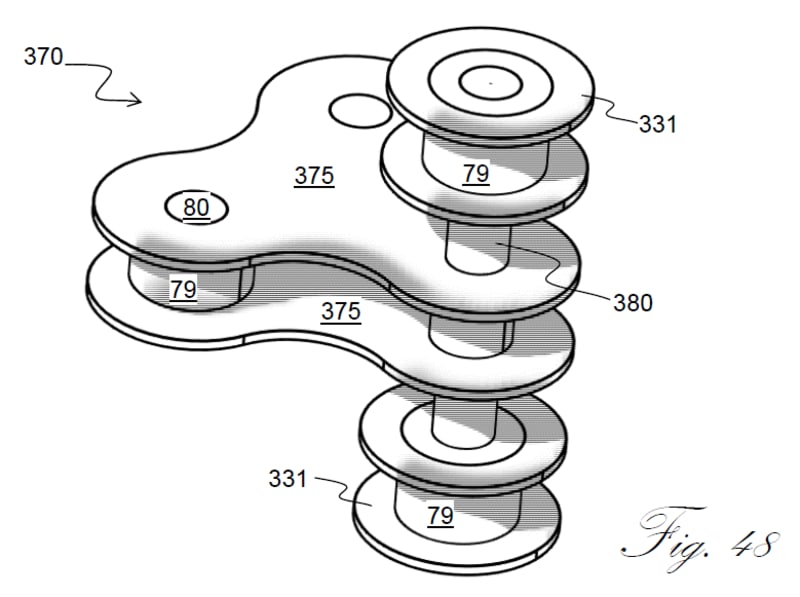Figure COLORS: A roller chain in prior art is a way of transmitting mechanical power from one place to another through linear links (like on a bicycle chain) arranged in or extending along a straight or nearly straight line “linear movement” that are assembled around on sprockets (GREEN-Positive and RED-Negative, layered over middle WHITE-Insulator) providing a rotating roller chain drive ELECTRIC circuit. Cylinders (PURPLE) and Pistons (ORANGE) in the illustration are OPEN "cross-sectional" views, so you can see the spacing (BLUE), just for illustration purposes. Sealed pistons are Stirling or heat engines, just heated and cooled by any heat, even focused Sunlight or nuclear elements. In DESIGN OPTION: Chain links are separate circuits in contact with Sprocket's faces (planes), both separate electric conductors are on each layered plane: GREEN-Positive and RED-Negative separated by "WHITE-Insulated" middle-materials with circuited electric components wired, between the links, providing wire motor or generator coils, piezoelectric wiring, sensors, valve controls, and other aerodynamic propulsion elements. Not done yet, but finishing a design, where sprockets are aircraft propulsion propellers and fans, in one project the whole aircraft's "aerodynamically" curved wing surface is rotating around the wing section on hybrid electric roller chains (in Patent Pending too).
INVENTION: “Triangular-chain link” (3-Points) replaces the prior art linear links (2-Points) assembled around on sprockets by providing a chain drive that extends a mechanical structure, an additional moment arm, at a greater radial distance from the center of sprocket’s conventional linear chain drive outer chain link surface in motion. The conventional past roller chain 2-Points traveling on sprockets relative to the 3rd-point of the triangular-chain link are still functioning in the same way as Prior Art, but with the addition of a triangular-chain link (FIG 41) an additional motion translational geometry of the 3rd Point is added to reciprocate rods of a piston during the movement from straight chain travel, CLOSED PISTONS, between the triangular-chain link's 3rd Points, then travel around the Circle-Arc of sprocket that OPENS PISTONS, a motion translational function happening twice around each of two sprocket Circle-Arcs: compressing and expanding piston-cylinder assemblies sequentially in a series, stretch and compress piezoelectric materials to drive the chain assembly or generate electricity from forced eWafer(TM) motion - like wind or water motion that can force movement between a pair of triangular-chain links stretching and compressing piezoelectrics in a cycle of motion translation.
BACKGROUND OF THE INVENTION: This invention teaches that the magnitude of torque depends on three quantities: the force applied, the length of the lever arm connecting the axis to the point of force application, and the angle between the force vector and the lever arm. The equation for the magnitude of a torque, arising from a perpendicular force: torque is multiplied, because it equals the distance to the center of rotation from the Tip-Point of Roller Chain's 3rd Point on triangular-chain links multiplied by the force applied to that Tip-Path. Thermal dynamic cycles need TIME to cycle, which this invention provides on Roller chain's extra length with more pistons.
Like this entry?
-
About the Entrant
- Name:David Zornes
- Type of entry:individual
- Software used for this entry:rhino 3d
- Patent status:pending








